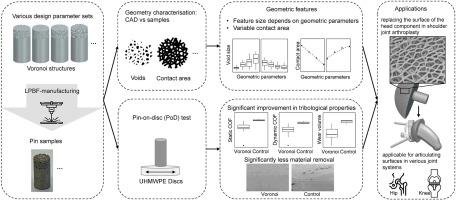激光粉末床熔接在润滑金属-聚合物滑动副中产生了Voronoi结构
IF 3.5
2区 医学
Q2 ENGINEERING, BIOMEDICAL
Journal of the Mechanical Behavior of Biomedical Materials
Pub Date : 2025-07-16
DOI:10.1016/j.jmbbm.2025.107138
引用次数: 0
摘要
人工关节的失效往往是由于磨损造成的,这促使研究人员探索材料改进、表面织构和涂层等有效的解决方案。本研究介绍了一种采用3D打印Voronoi结构来增强聚合物金属滑动磨损润滑的新方法,目的是延长人工关节系统的使用寿命。具体来说,本研究探讨了与超高分子量聚乙烯(UHMWPE)配对的Ti6Al4V Voronoi结构的几何形状和摩擦学性能之间的关系。结果表明,Voronoi结构中的孔隙尺寸可以通过操纵来匹配表面纹理方法中的特征尺寸,这表明了诱导水动力效应以减少摩擦的潜力。使用销盘(PoD)试验检测了Voronoi结构对减少摩擦和磨损的影响。与实心销组相比,采用Voronoi结构的销组静摩擦系数(COF)、动态摩擦系数(COF)和磨损体积的平均值分别降低了24.6%、29.4%和51.2%。在COF和Voronoi结构的几何参数之间观察到不明显的趋势。据推测,Voronoi结构内部相互连接的孔隙网络可以保存磨损碎片并保留润滑剂,从而可能提高动水压力,从而改善摩擦条件。此外,磨损轨迹的对比分析证实了Voronoi结构的有效减少磨损,并将磨损确定为主要磨损机制。本文章由计算机程序翻译,如有差异,请以英文原文为准。

Friction and wear reduction effect of laser powder bed fusion produced Voronoi structures in lubricated metal-polymer sliding pairs
The failure of artificial joints is often attributed to wear, prompting researchers to explore effective solutions such as material improvement, surface texturing and coating. This study introduces a novel approach of employing 3D printed Voronoi structures to enhance lubrication in polymer-metal sliding wear, with the aim of extending the longevity of artificial joint systems. Specifically, this study investigates the relationship between the geometries and tribological properties of Ti6Al4V Voronoi structures, paired with ultra-high-molecular-weight polyethylene (UHMWPE). The results indicate that the void size in Voronoi structures can be manipulated to match the feature size in the surface texturing approach, suggesting the potential to induce the hydrodynamic effect for friction reduction. The effect of Voronoi structures on reducing friction and wear was examined using pin-on-disc (PoD) tests. In comparison to the control group of solid pins, implementing Voronoi structures in the pins decreases the mean values of static coefficient of friction (COF), dynamic COF, and wear volume by 24.6 %, 29.4 %, and 51.2 %, respectively. Indistinct trends were observed between the COF and the geometric parameters of Voronoi structures. It is hypothesised that interconnected porosity networks within Voronoi structures may preserve wear debris and retain lubricant, potentially elevating hydrodynamic pressure and thereby improving the friction condition. Moreover, comparative analysis of the wear tracks confirms the effective wear reduction achieved by Voronoi structures, with abrasion identified as the primary wear mechanism.
求助全文
通过发布文献求助,成功后即可免费获取论文全文。
去求助
来源期刊

Journal of the Mechanical Behavior of Biomedical Materials
工程技术-材料科学:生物材料
CiteScore
7.20
自引率
7.70%
发文量
505
审稿时长
46 days
期刊介绍:
The Journal of the Mechanical Behavior of Biomedical Materials is concerned with the mechanical deformation, damage and failure under applied forces, of biological material (at the tissue, cellular and molecular levels) and of biomaterials, i.e. those materials which are designed to mimic or replace biological materials.
The primary focus of the journal is the synthesis of materials science, biology, and medical and dental science. Reports of fundamental scientific investigations are welcome, as are articles concerned with the practical application of materials in medical devices. Both experimental and theoretical work is of interest; theoretical papers will normally include comparison of predictions with experimental data, though we recognize that this may not always be appropriate. The journal also publishes technical notes concerned with emerging experimental or theoretical techniques, letters to the editor and, by invitation, review articles and papers describing existing techniques for the benefit of an interdisciplinary readership.
 求助内容:
求助内容: 应助结果提醒方式:
应助结果提醒方式:


